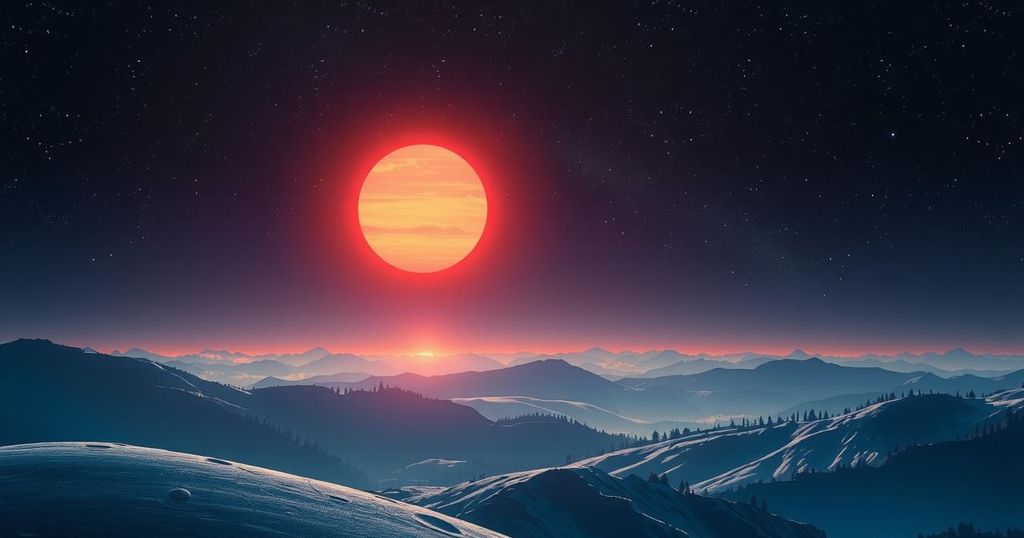Weather
AFRICA, ASIA, BURKINA FASO, CANADA, CLIMATE, COMMUNITY ENGAGEMENT, DOVER, EARTH, ENGLAND, EUROPE, GALLAN HEAD, GREENLAND, ICELAND, INDIA, JAPAN, MANCHESTER, NONE, NORTH AMERICA, NORTHERN ASIA, PA, RAIN, SCIENCE, SCOTLAND, SOUTH AMERICA, TECHNOLOGY, UK, UNITED KINGDOM, UNITED STATES, USA
Fatima Khan
0 Comments
Surya Grahan 2025: Key Details About the Upcoming Partial Solar Eclipse
The partial solar eclipse on March 29, 2025, also known as ‘Surya Grahan’, will see the Moon partially blocking the Sun. This event is visible across multiple regions globally, yet not in India. The eclipse will last approximately four hours, with safety precautions required for viewers. Notable phenomena such as double sunrise will occur in certain areas, with differing coverage percentages across various locations.
The year 2025 will witness its first solar eclipse, known as ‘Surya Grahan’ in India, occurring on March 29. This major celestial event will feature the Moon partially obstructing the Sun, although perfect alignment will not occur, resulting in a partial solar eclipse. This astronomical display will be visible from various regions worldwide, including the USA, Canada, South America, Europe, and Northern Asia; however, it will not be observable in India.
This solar eclipse is expected to showcase various phenomena, notably the appearance of a double sunrise in specific areas. For some locations, the eclipse will coincide with sunrise, while others will experience it during the afternoon, creating unique viewing opportunities across time zones.
In the UK, different areas will experience varying degrees of eclipse coverage. For instance, Gallan Head in northwest Scotland is projected to observe up to 47.9% coverage, whereas Dover in southwest England will see only 28.1% obstruction. Manchester is anticipated to have 36.1% coverage during the event.
To ensure the safety of viewers, essential precautions are advisable during the solar eclipse. Individuals should inspect their eclipse glasses for any damage before use and supervise children to ensure proper usage. Importantly, eclipse glasses must not be used with telescopes or cameras, as this can cause severe eye damage due to intense sunlight.
NASA suggests using certified solar viewing glasses, or handheld solar viewers, to safely observe the eclipse. Standard sunglasses, regardless of darkness, offer insufficient protection. For those without specialized eyewear, a pinhole projector can be used to safely view the Sun’s image indirectly.
Online, Google marks this rare event with an animation that activates upon searching terms such as ‘solar eclipse’ or ‘surya grahan,’ allowing users to visualize the celestial occurrence. However, direct viewing of the Sun during the eclipse without proper equipment is unsafe.
The solar eclipse will unfold at various times worldwide, dictated by local time zones. In much of the Americas, the eclipse will already be in progress at sunrise. Conversely, areas in western Europe and northwestern Africa will observe it in the late morning, while in eastern Europe and northern Asia, the event will occur in the afternoon or early evening.
While the solar eclipse will captivate audiences globally, it will not be visible in India. Regions such as parts of North and South America, Europe, and northern Asia will enjoy this extraordinary event, including significant portions of Greenland and Iceland.
The eclipse will lead to the rare double sunrise phenomenon, particularly for residents in North America and Canada, experiencing the Sun appearing to rise twice due to the Moon’s silhouette.
In Indian Standard Time (IST), this solar eclipse is projected to commence at 2:20 PM, peak at 4:17 PM, and conclude by 6:13 PM, lasting approximately four hours.
The partial solar eclipse of March 29, 2025, is set to be a significant celestial event, visible across much of the globe but not in India. Various regions will experience differing degrees of eclipse coverage, with safety precautions necessary for viewing. The phenomenon of double sunrise will enhance the experience for some observers, making this event historically notable. The eclipse will occur within a structured timeframe, making it essential for interested viewers to plan accordingly.
Original Source: www.hindustantimes.com




Post Comment